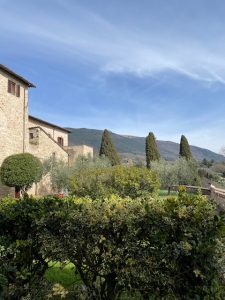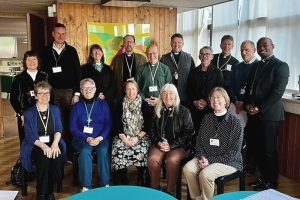Rev. Margaret testified in favor of a resolution for General Convention that supports adding a worldwide, ecumenical Feast Day of Creation to our liturgical calendar. In an article reporting on the hearing (6/10/24), Episcopal News Service summarized her comments in this fifth and final online hearing ahead of the 81st General Convention, which will meet in Louisville, KY, June 23-28.
Author Archives: mbj
Earth Day: Abide in love
My message today boils down to three words: Abide in love. I hope you’ll keep listening, but I will confess right up front that everything I have to say will be a riff on that. Years ago, when I was in seminary, someone told me that a preacher should never say the word “love” in a sermon unless the readings assigned for the day clearly justified it. It’s advice I’ve ignored in pretty much every sermon I’ve ever preached, but if any day called for preaching about love, today would be the day. By my count, the word “love” shows up in some form a full 29 times in today’s passage from the First Letter of John: “Beloved, let us love one another, because love is from God; everyone who loves is born of God and knows God. Whoever does not love does not know God, for God is love…” (1 John 4:7-8). And so on.
And there’s another word that gets almost as brisk a workout in today’s readings: the word “abide.” That one shows up 14 times in our readings from the Letter of John and the Gospel of John. Put them together, and here’s what you get: “Abide in love,” and John himself will say it: “Those who abide in love abide in God, and God abides in them” (1 John 4:16b).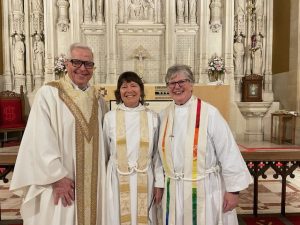
 So, when Jesus says, “Abide in love,” I hear a summons to take hold of the deep ecological meaning of what it means to follow him. We need to hear that call to abide in love, for we have broken faith with the living world. Our society’s relentless extraction and burning of coal, gas, and oil is pushing our planet wildly out of balance. Every living system is in decline and the web of life is unraveling before our eyes. The world keeps breaking records for heat, and last year was the warmest year on record, by far. We now live in a world where atmospheric rivers can fill the sky and a month of rain can fall in one day; where wildfires can be so intense that they create their own weather; where hurricanes can be so fierce that we need to create new categories for storms. It’s not surprising that many of us can lie awake at night, wondering what the future will hold for our children.
So – now is the time to reclaim our God-given connection with the earth. Now is the time to renew our union with God and all God’s creation, which includes not just our human fellows but all living creatures and the larger eco-systems on which we all depend.
I hope you’ll join me after the service to talk about what we can do. Now is the time, as theologian Sallie McFague would say, to recognize that the world is not a hotel, but our home.1 When we visit a hotel, we may feel entitled to use copious amount of hot water, to throw towels on the floor, to use and discard everything in sight and then to head to the next hotel – in short, to exercise what she calls the “Kleenex perspective” of the world. But when we realize that in fact the earth is our home – that God created it and loves every inch of it and entrusts it to our care – then everything changes. We realize that we live here; we belong here; we can no longer tolerate a lifestyle that exhausts the planet’s resources and that treats land, sea, and sky alike as receptacles for waste.
In a few moments we will share the bread and wine of the Eucharist, given to us by God in Christ with such tenderness and at such great cost. We will gather at that holy table, as we always do, so that everything within us and around us can be lifted up and blessed – not only the bread and the wine, but, also, we ourselves, and the whole creation, every leaf of it and every grain of sand. Sharing the Eucharist helps us to perceive at last not only our own belovedness, our own blessedness in God, but also the fact that everyone is beloved, all beings are blessed. Everyone and everything are part of a sacred whole, and all living things are kin. In the strength of the blessed and broken bread and of the blessed and poured-out wine, we dare to hope that human beings will respond with grateful hearts and come to treat the world not as an object to exploit, but as a gift to receive, as something perishable and precious. We dare to hope that we will become at last who we were made to be, a blessing on the earth, a people who abide in love.
1. Sallie McFague, A New Climate for Theology: God, the World, and Global Warming, Minneapolis: Fortress Press, 2008, p. 53.
So, when Jesus says, “Abide in love,” I hear a summons to take hold of the deep ecological meaning of what it means to follow him. We need to hear that call to abide in love, for we have broken faith with the living world. Our society’s relentless extraction and burning of coal, gas, and oil is pushing our planet wildly out of balance. Every living system is in decline and the web of life is unraveling before our eyes. The world keeps breaking records for heat, and last year was the warmest year on record, by far. We now live in a world where atmospheric rivers can fill the sky and a month of rain can fall in one day; where wildfires can be so intense that they create their own weather; where hurricanes can be so fierce that we need to create new categories for storms. It’s not surprising that many of us can lie awake at night, wondering what the future will hold for our children.
So – now is the time to reclaim our God-given connection with the earth. Now is the time to renew our union with God and all God’s creation, which includes not just our human fellows but all living creatures and the larger eco-systems on which we all depend.
I hope you’ll join me after the service to talk about what we can do. Now is the time, as theologian Sallie McFague would say, to recognize that the world is not a hotel, but our home.1 When we visit a hotel, we may feel entitled to use copious amount of hot water, to throw towels on the floor, to use and discard everything in sight and then to head to the next hotel – in short, to exercise what she calls the “Kleenex perspective” of the world. But when we realize that in fact the earth is our home – that God created it and loves every inch of it and entrusts it to our care – then everything changes. We realize that we live here; we belong here; we can no longer tolerate a lifestyle that exhausts the planet’s resources and that treats land, sea, and sky alike as receptacles for waste.
In a few moments we will share the bread and wine of the Eucharist, given to us by God in Christ with such tenderness and at such great cost. We will gather at that holy table, as we always do, so that everything within us and around us can be lifted up and blessed – not only the bread and the wine, but, also, we ourselves, and the whole creation, every leaf of it and every grain of sand. Sharing the Eucharist helps us to perceive at last not only our own belovedness, our own blessedness in God, but also the fact that everyone is beloved, all beings are blessed. Everyone and everything are part of a sacred whole, and all living things are kin. In the strength of the blessed and broken bread and of the blessed and poured-out wine, we dare to hope that human beings will respond with grateful hearts and come to treat the world not as an object to exploit, but as a gift to receive, as something perishable and precious. We dare to hope that we will become at last who we were made to be, a blessing on the earth, a people who abide in love.
1. Sallie McFague, A New Climate for Theology: God, the World, and Global Warming, Minneapolis: Fortress Press, 2008, p. 53. Following the Good Shepherd on Earth Day
Friends, it’s been a joy to spend the day together, to celebrate the pilot phase of An Episcopal Path to Creation Justice, to learn from each other, and to feast on the wisdom of some of our generation’s most visionary thinkers.1 And isn’t it fitting that we end the day in worship! Worship is at the heart of everything we do.
Saying that reminds me of an afternoon ten years ago when I had just started my job as Missioner for Creation Care in the Diocese of Western Mass. There was so much we needed to figure out, like: What kind of Creation care webpages do we need to build? What material should they include? Should we start a monthly newsletter? Creating a diocesan ministry around Creation care was all so new, and we were making it up as we went along. So, what did I do? I headed straight for Vicki Ix, our diocesan Canon for Communication, so that we could have a good long talk and do some brainstorming. That’s where we came up with the framework for Creation care that we’ve been using in our diocese ever since – Pray, Learn, Act, and Advocate. It’s the framework behind An Episcopal Path to Creation Justice, and it’s one that several other dioceses around the Church have begun to pick up, too. I like this framing because it’s so comprehensive, making it clear that a full-bodied, wholehearted, clear-eyed response to our Gospel calling to love God and neighbor commits us to keep learning, to keep acting, to keep advocating, and – yes – to keep praying.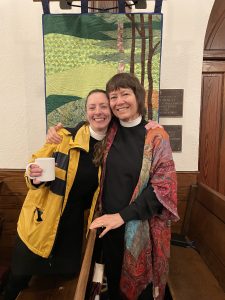
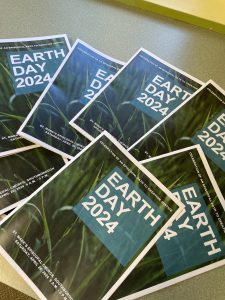 But when we turn to the Good Shepherd, we touch the sacred unity within and beyond all things. We touch the Ground of our being. We meet the One through whom all things were made, in whom all things hold together, and toward whom all things converge (Colossians 1:16-17). At a time when so much seems to be divided and falling apart, we’re invited to sense the underlying wholeness and unity of all things and to sense the love that embraces all things, connects all things, sustains all things. On the surface, in the realm of our five senses, we may notice only differences, only what separates us from each other, but in the deep center of reality we meet the good shepherd who is holding everything together and luring us into communion with each other and with God.
We hear the shepherd’s voice when we take time to quiet ourselves in prayer, to sit in solitude and silence and listen to the inner voice of love that is always sounding in our hearts. The good shepherd is the one who knows us through and through and who calls us each by name. Held in the embrace of that intimate love, we don’t have to keep trying to hold ourselves together – we are free to let go, free to fall apart, free to let ourselves feel our grief, feel our anger and fear as we respond to the climate crisis and to all the challenges of our lives. The good shepherd is there to hold what we cannot hold by ourselves, there to listen, there to protect and keep company, there to help us understand how deeply we are loved – and not just we ourselves, but all people – and not just all people, but all beings, the whole of God’s creation.
That very personal experience of being loved keeps getting larger! The circle of love keeps expanding! As Jesus says, “I have other sheep that do not belong to this fold. I must bring them also, and they will listen to my voice. So there will be one flock, one shepherd” (John 10:16-17). It’s as if, beneath all the ways that human beings try to separate ourselves from each other and from the rest of the natural world, presuming that we can dominate and destroy with impunity – Jesus keeps calling us forward into one living, sacred whole.
But when we turn to the Good Shepherd, we touch the sacred unity within and beyond all things. We touch the Ground of our being. We meet the One through whom all things were made, in whom all things hold together, and toward whom all things converge (Colossians 1:16-17). At a time when so much seems to be divided and falling apart, we’re invited to sense the underlying wholeness and unity of all things and to sense the love that embraces all things, connects all things, sustains all things. On the surface, in the realm of our five senses, we may notice only differences, only what separates us from each other, but in the deep center of reality we meet the good shepherd who is holding everything together and luring us into communion with each other and with God.
We hear the shepherd’s voice when we take time to quiet ourselves in prayer, to sit in solitude and silence and listen to the inner voice of love that is always sounding in our hearts. The good shepherd is the one who knows us through and through and who calls us each by name. Held in the embrace of that intimate love, we don’t have to keep trying to hold ourselves together – we are free to let go, free to fall apart, free to let ourselves feel our grief, feel our anger and fear as we respond to the climate crisis and to all the challenges of our lives. The good shepherd is there to hold what we cannot hold by ourselves, there to listen, there to protect and keep company, there to help us understand how deeply we are loved – and not just we ourselves, but all people – and not just all people, but all beings, the whole of God’s creation.
That very personal experience of being loved keeps getting larger! The circle of love keeps expanding! As Jesus says, “I have other sheep that do not belong to this fold. I must bring them also, and they will listen to my voice. So there will be one flock, one shepherd” (John 10:16-17). It’s as if, beneath all the ways that human beings try to separate ourselves from each other and from the rest of the natural world, presuming that we can dominate and destroy with impunity – Jesus keeps calling us forward into one living, sacred whole.
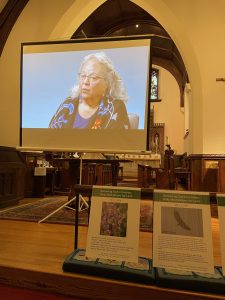
Rev. Margaret is quoted in The Martha’s Vineyard Times in an article (3/27/24) about how faith communities on the Island are working together to address climate change. She will head to Martha’s Vineyard on April 5 for a weekend of climate-related events, including speaking at the Hebrew Center’s Shabbat service, preaching at St. Andrew’s Episcopal Church, and leading a retreat on climate resilience for people of all faiths. The theme of the weekend is One Home One Future, the national multifaith campaign to educate, support, and mobilize congregations around climate action.
I am back from a trip to Assisi, Italy, to join an Anglican delegation of liturgists, theologians, and church leaders at an ecumenical gathering hosted by the Laudato Si’ Research Institute, and sponsored by the Anglican Communion, the Lutheran World Federation, the World Communion of Reformed Churches, the World Council of Churches, and other partners.
The seminar had a mouthful of a title: The Feast of Creation and the Mystery of Creation: Ecumenism, Theology, Liturgy, and Signs of the Times in Dialogue. But its focus was clear: Has the time come to add a Feast of Creation to the liturgical calendars of Western Churches?
It was a delight to make new friends and a thrill to meet the Rev. Canon Dr. Rachel Mash at long last. Based in South Africa, she serves as secretary of the Anglican Communion Environmental Network, and she is one of the leading lights in the movement to support a Season of Creation. In her remarks at the conference, “A new season for the calendar of the Church? I hope so!,” she gave a brief overview of Anglican engagement in a Season of Creation and explained why many of us now believe that the time is ripe for the Feast of Creation to be formally integrated into Western liturgical calendars. (I hasten to correct two points in her address: first, I am by no means solely responsible for the Season of Creation worship guides that were released in many Episcopal dioceses in 2022 and 2023 – my colleague, the Rev. John Lein, did most of the heavy lifting; and second, 28 dioceses, not 16, endorsed last year’s edition.)
The ecumenical seminar began and ended with prayer. Before plunging into questions of theology, liturgy, and practice, we spent an afternoon in the garden behind San Damiano, the church that St. Francis re-built and where he wrote most of his Canticle of the Creatures. In the company of birdsong and wind, sunshine and grasses, we sang and prayed our way through his poem. Then, after walking back into town, we gathered outside Cittadella Laudato Si for a prayerful, sunset contemplation of Brother Sun. Again, after the conference ended, many of us hiked in silence up Mount Subasio, the mountain where St. Francis and his followers lived and prayed in caves, and we shared in an ecumenical outdoor Eucharist at the altar of St. Francis.
Conversations at the ecumenical seminar were lively, intense, and sometimes deeply moving. None of us yet knows what will come of this effort. But I do know that it was a blessing to spend time with global Christians from diverse communities who share a passion both for the God who creates, redeems, and sustains all things and for the beautiful, threatened planet that God loves so much.
Here’s an excerpt from a prayer composed by one of the liturgical scholars who attended the Assisi conference, with my suggested addition in brackets.
O loving God, who spoke
and all things were created –
O eternal Word made flesh,
who became one with your creation –
O creator Spirit, who breathes in us,
who renews the face of the earth –
O holy and glorious Trinity,
we praise you and we pray to you
with all our heart!
…
Bless us with clarity and courage
for our mission to cherish and tend
earth and air, seas and rivers,
peoples and communities.
Guide your Church
to the patterns of prayer that will form us
to be [loving kin of our fellow creatures] and
good stewards
of all that you have entrusted to us.
O holy and glorious Trinity, Creator God,
we praise you and we pray to you
with all our heart. Amen.
___________________________________________________________________________________________
Episcopal News Service published a good article (3/25/24) about the seminar: “Anglicans take part in ecumenical seminar in Assisi about God as creator“
This is a slightly adapted text for a video I created at the request of the Episcopal Church in Colorado as part of its Lenten series, “Journey through Lament: Leaning into the Brokenness of Our Communities and World.” The YouTube video is available here.
At the end of Morning Prayer and Evening Prayer, the officiant sometimes concludes the service with this line from Paul’s Letter to the Romans: “May the God of hope fill us with all joy and peace in believing, so that we may abound in hope by the power of the Holy Spirit” (Romans 15:13). Our God of hope wants us to abound in hope! Hope is one of the great Christian virtues, but honestly, given the social and ecological breakdown going on all around us, where do we find hope? How do we maintain it? Take climate change, for instance. The relentless extraction and burning of coal, gas, and oil is pushing our planet wildly out of balance. Every living system is in decline and the web of life is unraveling before our eyes. We now live in a world where atmospheric rivers can fill the sky and a month of rain can fall in one day; where wildfires can be so intense that they create their own weather; where hurricanes can be so fierce that we need to create new categories for storms.
What shall we say about hope? Hope is forward-facing – it’s the capacity to look toward the future with confidence that something good is ahead – but then we learn that by 2050, over a billion people could be displaced due to natural disasters and climate change.1 Or we learn that current global climate policies set the world on a path to heat by about 2.7 degrees Celsius by 2100, which would threaten modern human civilization within the lifespan of children born today.2 Hear things like that and it’s easy to be overcome by helplessness and by what theologian Sallie McFague calls a “crushing state of futility.”3 Say the word “hope” too glibly and it reeks of escapism and wishful thinking.
But I’m here to tell you that it’s precisely in a time like this, when the stakes are so high, that we need to recover the power of Christian hope.
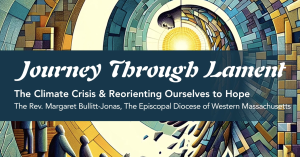 What happens in your body when you don’t feel hope? If you’re like me, you contract. When I go into a hopeless place about the climate crisis, I feel small, helpless, alone. There’s nothing I can do, nothing to be done, it’s all going to hell, and I might as well quit trying to change that – might as well curl up in a ball of anxiety and despair, or distract and numb myself – maybe with entertainment, a drink, shopping, something.
What happens in your body when you don’t feel hope? If you’re like me, you contract. When I go into a hopeless place about the climate crisis, I feel small, helpless, alone. There’s nothing I can do, nothing to be done, it’s all going to hell, and I might as well quit trying to change that – might as well curl up in a ball of anxiety and despair, or distract and numb myself – maybe with entertainment, a drink, shopping, something.
Hope feels different in the body. Hope expands us, it connects us, it moves us out of withdrawal into engagement, out of isolation into relationship. When we’re in a hopeful place, we find energy and courage to act. We know that what we do matters and that even if we can’t do everything, we won’t refuse to do the something that we can do.
How do we nourish hope? It helps to remember that hope does not exist on its own. St. Paul repeatedly links hope with other virtues, other powers of the soul, such as faith and love. In his First Letter to the Corinthians, he writes: “Faith, hope, and love abide, these three; and the greatest of these is love” (1 Corinthians 13:13). I imagine hope standing in the middle, holding hands with her two sisters – faith and love.
So, when we find ourselves in a hopeless place, it’s good to remember faith. Take hold of faith! Faith is confidence in things not seen (Hebrews 11:1), in the hidden God who sent us into this world, who is with us now, and who will welcome us home at our journey’s end. Hope arises from faith, because with the Unseen One who loves me, I can step into the future, asking: What shall we do together? I love You and I want to live and act in alignment with You. Even if I see no outward hope, my hope is in You. And I know that whatever happens, whether I live or die, I am yours (c.f. Romans 14:8).
Again, when we find ourselves in a hopeless place, it’s good to remember love. There is so much to love in this beautiful world of ours, so much that we want to save. We can’t save it all, but we can commit ourselves to saving everything we can. Likewise, we can hold in mind the young people in our lives with whom we have a heartfelt connection to the future. Our love for those young people strengthens our resolve to live and act in hope. We don’t want to fail them. We want to protect, as best we can, the conditions that will make their lives safe and peaceful and possible in the decades ahead. What do you love so much that you would give everything, perhaps your very life, to protect it?
And maybe we haven’t even met the ones who most count on us to be living signs of hope. Terry Tempest Williams writes, “The eyes of the future are looking back at us and they are praying for us to see beyond our own time. They are kneeling with hands clasped that we might act with restraint, that we might leave room for the life that is destined to come.”4
Christian hope, fortified by faith and love, can keep us steady in a turbulent time. Jesus sets before us a great hope that the reign of God will come on Earth. As long as we live, we intend to pray and work for God’s will to be done on Earth as it is in heaven. That’s our big mission, our constant hope, the hope that will never fade away. In the near term, our hopes must be flexible and multiple, like strategic plans that we change as needed while we carry out the larger mission. In the near term, hope is a shapeshifter: depending on outer circumstances, our hopes change; we hope for this, we hope for that, and our hopes ebb and flow, rise and fall, depending on how things are going and how things turn out. Of course, that’s life, that’s normal, that’s how it works, but if that kind of hope – hope in the things of this world – is all we’ve got, we are vulnerable to despair: if my candidate wins, if that policy passes, if my biopsy comes back clean – hurray! my hope is fulfilled! And if I don’t get the outcome I want, then my hope drains away. Unless I have some other, deeper source of hope, I bounce around like a little boat on the surface of the ocean.
Christian hope gives us the deep grounding we need: it springs from deep within us and is replenished day by day from our ongoing relationship with a God who loves us and all creation and who will never let us go. Christian hope sets us free to release the false hopes to which we’ve probably been clinging – hopes like: “When it comes to climate change, everything will turn out fine. Progress will continue. Experts will figure this out. Someone else will fix this.” Such idle hopes are fantasies that give hope a bad name – no wonder “hope” in climate circles is sometimes denounced as a sop and a drug, as nothing more than “Hope-ium” to soothe us, to keep us passive, quiet, and feeling good.
But that’s not the same as Christian hope. Christian hope is not some vague “pie in the sky when you die” – no, it looks squarely at the truth and accepts with bracing clarity the reality and tragedy of sin and suffering. Let’s not kid ourselves. Modern society has overshot the planet’s limits. We’re living as if the Earth had no limits, as if we can extract, burn, consume, and waste to our heart’s content, without harmful consequence. No wonder the living world is being crucified and our complex society is reeling and might collapse. We do well to stand at the foot of the cross, to acknowledge our sorrow, guilt, and shame, and to pray for guidance and forgiveness. Our faith gives us space to lament and grieve – to love what God loves and to weep with a broken heart with Jesus.
Christian hope accepts reality, but acceptance is not the same as resignation. Christian hope rejects defeatism and spurs us into action. And it gives direction and purpose to our lives. God has planted in our hearts a deep desire, an unquenchable hope for justice, for kindness, for the Earth to be filled with the glory of God as the waters cover the sea. This is the world that I hope for, and when that hope is held before my eyes, I know what I should do.
The cross is sometimes held before a Christian’s eyes when they are on the point of death. Why? Because in the cross is our hope: amidst agony, violence, and death, amidst humiliation and shame, amidst the worst that human beings can do to each other and to the suffering Earth, God’s loving power and presence endure. Through the power of God revealed on the cross, life will rise again from the dead, though we don’t know how.
That’s the fierce and holy hope that sends us out to plant gardens and save forests, to install solar panels and build resilient communities, to listen to the voice of indigenous people and racial minorities, to push banks to quit funding fossil fuels, to lobby for smart regulations, to vote for climate champions, to change our lifestyle – what we buy, what we eat, how we build and heat our homes. It pushes us out, it drives us to connect with groups like Greenfaith, Third Act, and One Home One Future, and even to carry out acts of civil disobedience and spend time in jail.
The historian and activist Rebecca Solnit describes hope well when she says: “Hope is not like a lottery ticket you can sit on the sofa and clutch, feeling lucky… Hope is an axe you break down doors with in an emergency…Hope should shove you out the door, because it will take everything you have to steer the future away from endless war, from the annihilation of the earth’s treasures and the grinding down of the poor and marginal… Hope,” she says, “calls for action; action is impossible without hope…To hope is to give yourself to the future, and that commitment to the future makes the present inhabitable.”5
So, here we are, breathing in God’s Spirit with every breath, standing in hope with faith and love beside us, renewing our resolve to do everything we can to save life as it has evolved on Earth, even as we let go the outcome and entrust the results to God.
I’ll end with this. Years ago, I tried to name my ultimate hope and what I wanted to embody in my life. I came up with this statement: I am the possibility of the love of God being fully expressed in the world. That’s my North Star – in a sense that’s my identity, who I truly am, the purpose for which I was born. Until the day I die I want to be the possibility of the love of God being fully expressed, fully known, fully embodied in the world, no matter what happens. That’s my deepest hope. How would you name yours?
Here’s what I want to say: Decide what you hope for and then live inside that hope.
Questions for reflection and discussion:
1. What happens in your body when you don’t feel hope?
2. Have you ever thought of hope as having power?
3. The Rev. Margaret Bullitt-Jonas says that hope is forward facing. What do you think she means by this?
4. Hope moves us out of withdrawal and into engagement. What is something you can do personally when it comes to the changing climate and ecological devastation? What is something we can do together?
5. What is the difference between hope and Christian hope?
6. The Rev. Margaret Bullitt-Jonas says that Christian hope holds hands with faith and love. How do you nourish your hope with faith and love, so it doesn’t fade away?
7. What does it look like to take hold of faith when we’re in a hopeless place?
8. What do you love so much that you would give everything, perhaps your very life, to protect it?
9. How do we share our deep Christian hope with people outside our congregations?
10. The video mentions Rebecca Solnit’s quote that “Action is impossible without hope,” and “Hope should shove you out the door.” How can you commit to the future so that the present is inhabitable?
11. The Rev. Margaret Bullitt-Jonas says that her ultimate hope is to be “the possibility of the presence and love of God being fully expressed in the world.” She invites us to name our ultimate hope and to live inside it. What is your ultimate hope?
________________________________________________________________________________________________
The video can be viewed on YouTube here.
1. https://www.ncbi.nlm.nih.gov/pmc/articles/PMC10037158/
2. https://insideclimatenews.org/news/28012024/with-world-warming-scientists-warn-of-unrest-and-authoritarian-backlash/
3. Sallie McFague, A New Climate for Theology: God, the World, and Global Warming (Minneapolis: Fortress Press: 2008), p. 157.
4. Terry Tempest Williams, Red: Passion and Patience in the Desert
5. Rebecca Solnit, Hope in the Dark: Untold Histories, Wild Possibilities (Chicago, IL: 2004, 2006, 3rd ed.), p. 4
Rev. Margaret created a short video for the Episcopal Church in Colorado,“Climate Crisis & Reorienting Ourselves to Hope.” It’s the final video in a five-week Lenten series for the diocese, entitled Journey through Lament: Leaning into the Brokenness of Our Communities and World.
You can view the video here.
Questions for reflection and discussion:
1. What happens in your body when you don’t feel hope?
2. Have you ever thought of hope as having power?
3. The Rev. Margaret Bullitt-Jonas says that hope is forward facing. What do you think she means by this?
4. Hope moves us out of withdrawal and into engagement. What is something you can do personally when it comes to the changing climate and ecological devastation? What is something we can do together?
5. What is the difference between hope and Christian hope?
6. The Rev. Margaret Bullitt-Jonas says that Christian hope holds hands with faith and love. How do you nourish your hope with faith and love, so it doesn’t fade away?
7. What does it look like to take hold of faith when we’re in a hopeless place?
8. What do you love so much that you would give everything, perhaps your very life, to protect it?
9. How do we share our deep Christian hope with people outside our congregations?
10. The video mentions Rebecca Solnit’s quote that “Action is impossible without hope,” and “Hope should shove you out the door.” How can you commit to the future so that the present is inhabitable?
11. The Rev. Margaret Bullitt-Jonas says that her ultimate hope is to be “the possibility of the presence and love of God being fully expressed in the world.” She invites us to name our ultimate hope and to live inside it. What is your ultimate hope?
Rev. Margaret is one of many contributors to a new devotional booklet for Lent and Easter now available from the Episcopal Dioceses of Massachusetts and Vermont. Presented with beautiful graphics, the devotional is entitled “Baptism and Collaboration in the Body of Christ.” The devotional features lay, ordained and monastic voices reflecting on the daily Scriptures of the season and the various “Will you…” questions of the baptismal covenant:
- Will you continue in the apostles’ teaching and fellowship in the breaking of the bread and in the prayers?
- Will you persevere in resisting evil, and whenever you fall into sin, repent and return to the Lord?
- Will you proclaim by word and example the Good News of God in Jesus Christ?
- Will you seek and serve Christ in all persons, loving your neighbor as yourself?
- Will you strive for justice and peace among all people, and respect the dignity of every human being?
- Will you cherish the wondrous works of God, and protect and restore the beauty and integrity of all creation?
Put your hand out. Do you feel a thread? To what is it connected? Where does it lead?
I started playing with these questions after reading The Princess and the Goblin, a fantasy by George MacDonald, whose work influenced Lewis Carroll, G.K. Chesterton, J.R.R. Tolkien, and C.S. Lewis. This classic children’s story is full of mythic, archetypal symbols that would resonate with Carl Jung. There’s a royal castle aboveground, a goblins’ castle underground, a princess, a peasant, a magic fire, a magic ring, and a secret tower where the princess’ beautiful great-great-grandmother lives.

But the image that particularly drew my attention was the image of an invisible, sacred thread. The great-great-grandmother sits in the tower, spinning a delicate thread woven from spiderwebs and filled with moonlight. She ties the thread to a ring and gives the ring to the young princess. She tells Princess Irene that when she is frightened or in trouble, she should put the ring under her pillow and follow the thread.
“Then you must lay your finger, the same that wore the ring, upon the thread, and follow the thread wherever it leads you.”
“Oh, how delightful! It will lead me to you, grandmother, I know!”
“Yes. But, remember, it may seem to you a very roundabout way indeed, and you must not doubt the thread. Of one thing you may be sure, that while you hold it, I hold it too.”1
Sure enough – when Irene awakens one morning to a frightful disturbance, she puts the ring under her pillow and lays her finger on her grandmother’s thread. Although she can’t see the thread, she can feel it under her fingers. To her surprise, it leads her outdoors, away from her grandmother’s tower, up a steep mountainside and then down into caverns deep underground, where she reaches an impenetrable dead-end:
…[She] came to a huge heap of stones, piled in a slope against the wall of the cavern… [The thread] vanished through the heap of stones, and left her standing on it, with her face to the solid rock. For one terrible moment she felt as if her grandmother had forsaken her.2
Dismayed, Irene begins to weep. At length she decides to follow the thread backwards and go home.
But the instant she tried to feel it backwards, it vanished from her touch. Forward, it led her hand up to the heap of stones – backwards it seemed nowhere.3
Irene is alone in the dark with no way forward, no way out, and no way through. She weeps in despair.
I won’t explain what happens next – you’ll have to read this wonderful story for yourself. But here’s the point: by daring to follow the thread with a trusting heart and by doing whatever she must to stay connected with the thread – even if it demands all her courage, even if it requires the physical effort of laboring in the dark and enduring an aching back and bleeding hands and fingers – the princess not only finds her way to freedom but also saves the life of her friend, who in turn saves everyone from the goblins.
Entranced by the idea of following a thread, I began musing on the threads that appear in legends and folklore around the world, from Ariadne’s thread that guides Theseus out of the labyrinth of the Minotaur to the invisible red thread of Chinese mythology that connects two people who are destined to meet. I got curious about whether there might be threads to follow in the Bible. Sure enough, I quickly found references to red threads, blue threads, and even spiders’ threads, but nothing about following a thread. Finally, in Chapter 11 of the book of Hosea, I found what I was looking for.
The prophet Hosea portrays God’s compassion in terms as gentle as George MacDonald’s account of the great-great-grandmother tending Princess Irene: like a devoted mother, God loves his/her children, teaches them to walk, and takes them up in the divine arms (Hosea 11:1-3). God says, “I was to them like those who lift infants to their cheeks. I bent down to them and fed them.” And God also says, “I led them with cords of human kindness, with bands of love” (Hosea 11:4).
Ah! There it was! God leads us by invisible cords of human kindness and bands of love. We are given an invisible thread to follow, and that thread connects us to a divine compassion as tender as a mother’s love.
Well, it seemed to me that following the thread was a tangible way to practice the presence of God. I began bringing the thread to mind as I went through the day. I imagined feeling it between my fingers. Was I following it as I made choices about what to do, what to say, how to say it?
A thread is a tiny thing, and an invisible thread seems like nothing at all. For all of us who are trying to accomplish the seemingly impossible – protect democracy from authoritarian rule, stabilize a climate hurtling toward chaos, build peace in a war-torn world, restore justice between races, stop gun violence (feel free to add whatever you like to the list) – in short, for all of us who feel called to a mission that we can’t do alone and that won’t be completed in our lifetime, it may be cold comfort to know that all we have is a thread to follow. Perhaps, like Princess Irene, we find ourselves alone in the dark with our face to solid rock.
Yet the thread of love is trustworthy. Following the thread will keep us on the right path, for when we hold the thread, we hold it with the One who holds it with us. We hear a lot these days about unraveling – the unraveling of society, the unraveling of the web of life – so, I wonder what would happen if we renewed our intention to follow the thread of love, wherever it leads. It’s a costly commitment, for it will demand all our courage and trust, all our dedication and resolve, but as we follow that thread, perhaps we will begin to reweave the fabric of our communities and re-knit our relationships with each other and the whole of Creation.
I will leave you with three offerings: several questions for reflection, a poem by William Stafford, and a meditation I cooked up on following the thread.
Questions for reflection
Are you aware of following an invisible thread as you go through your day? What is that thread? Is there a guide-rope you hold on to that connects you with the sacred, with the divine?
How do you follow it? Maybe you pay attention to your imagination and intuition, to hunches and synchronicities, to dreams. Maybe you take time to meditate and pray, so that your awareness can become more sensitive to what it feels like to touch the thread.
To what is your thread connected? The thread in George MacDonald’s story doesn’t simply hang in space – it remains forever connected to the girl’s great-great-grandmother, a mysterious, sacred expression of the Divine Feminine. The thread in Hosea’s passage connects with a compassionate God. Who is holding the thread with you and leading you with bands of love? Is it Jesus? Is it Mary? Is it the Holy Spirit? Is there an image of God that speaks to you just now? Following the thread keeps you in close relationship with the One who is leading you and who loves you utterly.
As we head into a new year is this an opportune moment to renew your commitment to following the thread?
A poem by William Stafford: The Way It Is
There’s a thread you follow. It goes among
things that change. But it doesn’t change.
People wonder about what you are pursuing.
You have to explain about the thread.
But it is hard for others to see.
While you hold it you can’t get lost.
Tragedies happen; people get hurt
or die; and you suffer and get old.
Nothing you do can stop time’s unfolding.
You don’t ever let go of the thread.
A meditation on following the thread
Take your mythic imagination and go outside for an intuitive walk to follow the thread. Begin by walking slowly and in silence. Notice everything you can – sights, sounds, smells, temperature. Drop out of your thinking, planning mind. Welcome your sensory experience.
After a while, when you feel fully present, pause to imagine that you’re holding an invisible thread that connects you to the Source of love. You might imagine feeling it between your fingers. You might imagine it being connected to your heart. To what or to whom is your thread connected? Let images come to you.
Walk slowly and follow where your thread is leading. Let your intuition guide you. Don’t work too hard or try to figure anything out – hold the thread lightly. Notice: What draws your attention? Why? Do you feel led to go somewhere or do you feel invited to stay still? How is love showing up? What is it like to follow the thread?
_______________________________________________________________________________________________________________________________
1. George MacDonald, The Princess and the Goblin (1872), illustrated by Jessie Willcox Smith (1920), Chapter 15.
2. MacDonald, Chapter 20.
3. Ibid.
The Episcopal Church and a new Season of Creation liturgy
Anglican Communion Environmental Network (ACEN) is creating a series of success stories about environmental justice at the parish and diocesan levels, “Action for Change: Mobilizing the Church for Environmental Justice.” ACEN released a webinar in which Rev. Margaret tells the story of how she and Rev. John Eliott Lein created a Season of Creation liturgy in 2023 that was authorized by 27 dioceses in the Episcopal Church. The video was just released and is about 7.5 minutes long.
I particularly commend two other short videos in this series: a video by the Rev. Laurel Dykstra about Salal + Cedar, the extraordinary eco-justice ministry that she founded in the Anglican Diocese of New Westminster, centered in Vancouver, British Columbia, and a video by the Rev. Rachel Mash (Environmental Coordinator for the Anglican Church of Southern Africa) on “Greening Your Canons,” a brilliant way, as she puts it, to “change the DNA of the Church.”
